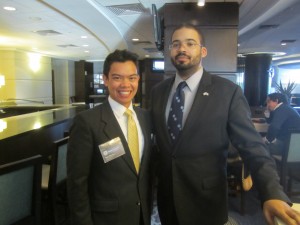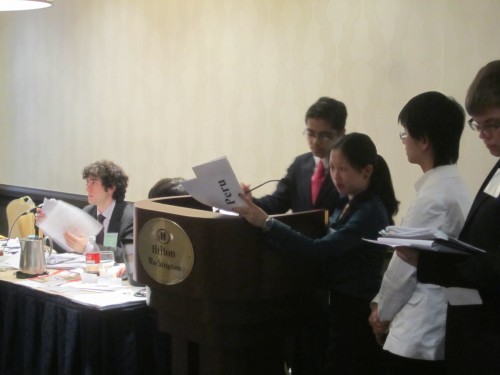
Me and Hayes Brown, a nine-year Model UN veteran and former GCIMUN Secretary-General
Liveblogging is hard work, and it takes a team of bloggers to provide in-depth coverage on a Model UN conference that’s the size of NAIMUN. So KFC and I brought backup.
I’m happy to have Hayes Brown, a nine-year Model UN veteran and former Secretary-General of GCIMUN, here at NAIMUN with me to blog about the conference. Hayes, a cybersecurity analyst for the Department of Homeland Security, also writes on international affairs for UN Dispatch and his blog, At Water’s Edge.
The room was engulfed in the roar of shuffling papers. As eleven working papers circulate the room, the delegates of the Nuclear Non-Proliferation Treaty (NPT) Review of 2015 were focused on how to bring their disparate ideas together in a way that garnered enough support to pass. Packed in shoulder to shoulder, the 100+ high school students were intent on finding the proper balance of sovereignty and security in enhancing the NPT. The time for poetic policy statements is past; these delegates have their nose to the grindstone, churning out substantive proposals.
The chair of the NPT, Brian Sergi, a senior studying Science and Technology for International Affairs, walked me through the process of building a committee at NAIMUN. Prepping for a conference the size of NAIMUN, with its thirty-nine committees is a full-year process, as he explained. The Chairs and Crisis Mangers apply to the Secretariat for their positions in the previous spring before a conference, usually laying out an idea for the committee they want to run. Brian, a four year veteran of the Georgetown International Relations Association, was approached with the idea for the NPT review by his Under Secretary-General, and quickly warmed to the idea.
From there, the Under Secretaries-General of the various organs work very closely with the applicants, the Director-General, the Chief of Staff, and the Secretary-General to structure the conference as a whole. As Brian told me, NAIMUN is loathe to repeat ideas, and tries not to repeat committees year after year – a difficult task when you’re running so many. But through “pretty interactive feedback” the senior staff and applicants manage to bang out a program of committees each year.

Brian Sergi chairs the 2015 Nuclear Non-Proliferation Treaty Review Committee
In the fall, Brian informed me, the training really picks up its pace. As befitting such a large conference, with such a large talent pool of trainers, the training manages to be pretty specific. A large session was held on Parliamentary Procedure, as well as sessions for newer staffers and the Chairs and Crisis Managers separately, and large committees versus small committees. Rather than having many mass meetings with the same information being delivered to all the staff, the structure of the Secretariat allows for several breakout sessions to be possible.
Brian takes a second to pause in talking to me to talk to one of his delegates. Yemen and France are working together to bring together three working papers into one draft, and want to know the upper limits on length. Brian informs them that he’ll accept three pages double-spaced, and the delegates return to their caucus bloc to relay the news.
When it comes to chairing a committee the size of the NPT Review, Brian stressed two aspects to focus on. The first, is to be encouraging, with a relatively light-touch with the delegates. The second, a Chair has to make sure that you know your Parliamentary Procedure and the process for running your committee to a fault. If you have those two in a balance, ensuring that you’re being approachable, while proving that you know what you’re talking about, you’re golden.
The one challenge, Brian tells me as we wrap up, is making sure that the kids manage to stay interested throughout the lengthy committee sessions. Like most of NAIMUN’s committees, there’s a crisis element; a short video was shown in the morning to display some of the events that occurred between 2012 and 2015. As I leave the room, delegates are hotly debating additional protocols and enforcement measures. I don’t think he has to worry about keeping them interested.


